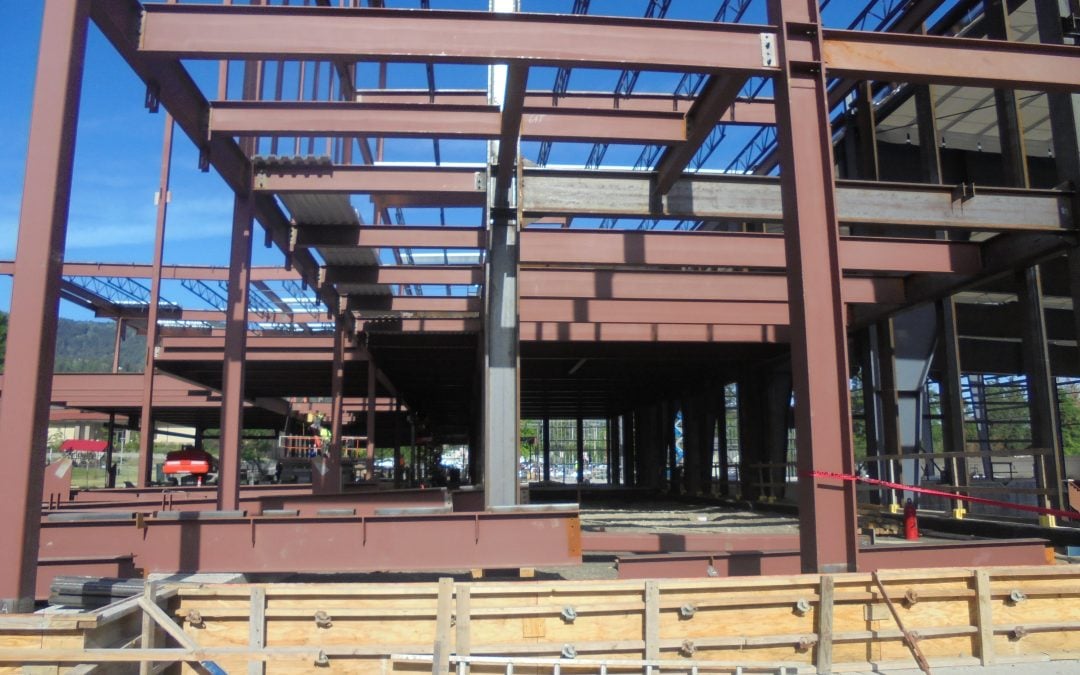At PSE Consulting Engineers, we know a lot about structural steel. It plays an integral part in nearly every modern construction project and can be fabricated into different shapes while still maintaining its strength. It can be formed into long structural items called beams. These beams not only come in different lengths and sizes but also in different shapes, angles, and specifications.
Design and Composition
The most common steel beam is the I-beam. The beam is composed of two horizontal flat surfaces called flanges connected by a horizontal component called a web.
The cross section is similar in form to a capital letter I with the serifs, hence, the name I-beam. When turned on its side, the beam will resemble the form of a capital letter H which is why it is also called an H-beam.
These beams are very strong, not just because they are made of metal but because of the way they are constructed. Most of the materials of the I-beam are located along the axial fibers which are the area that experience the most stress. The shape also plays an important role because the horizontal flanges resist bending movement while the web resists shear stress. These allow the beam to handle a variety of loads.
These beams will have different metal compositions depending on their application. There will also be variations in specifications including weight, flange width, flange thickness, beam height, and web thickness.
For example, some H-beams have thicker walls and flanges for use in platforms and in bridges. Variations in specifications will allow a builder to use the ideal I-beam for the structure based on factors such as resistance to deflection, vibration, bending, yielding, shear failure or buckling.

Uses
I-beams play a major role in the modern construction industry. If they are not used as the primary framework as in steel frames, these beams are used as primary supporting components. They play this part because as previously stated, these beams are able to handle large amounts of load from a variety of directions.
Benefits of Using I-beams
The use of I-beams also allows for aesthetically pleasing concepts and designs. Of course, traditional wooden beams are also aesthetically pleasing and allow you to mount or hang furnishings without sacrificing the integrity of the beam. It is not possible to nail or screw objects in an I-beam. Holes cannot be simply drilled in an I-beam without sacrificing or reducing its structural strength. However, steel has an advantage when it comes to strength.
Cost-Effective
Having a strong structural component like an I-beam can bring a lot of benefits to a construction project. A structure comprised of stronger materials will be composed of fewer components. Fewer components result in less overall cost due to materials and shipping.
It also increases the rate at which a construction project can be finished because there are fewer pieces to be installed. This can lower labor costs and other expenses related to build time. Overall, effective use of I-beams can make a project more cost-effective.
Fewer components also free up space, allowing for more spacious interiors. Since I-beams are also strong, they can be used to span wide areas with minimum support such as indoor arenas or they can be used to build higher structures such as skyscrapers.

Durable
Unlike traditional wood beams, I-beams are resistant to aging. They do not split, crack, or creep with ages and are not vulnerable to termites, mold, and mildew. They also do not warp, rot, or expand when there is an increase in moisture.
In contrast with wood, there are also no regional differences among different I-beam manufacturers because there are standards and regulations in the fabrication of these components. Trees are made by nature, so even though they may be cut to similar specifications, there will be unique differences like grain density among trees of the same species but located in different places.
Adaptable
Lastly, it is also easier to adapt a structure made with I-beams because they are readily available for structural addition or modification such as renovations or size expansions. Wood beams are not adaptable because they have less strength such that when redeveloping a residential building, the older and weaker wooden beams are usually replaced with I-beams.
With an ever-improving steel industry, steel beams will continue to be one of the main components of our modern structures; whether commercial or residential. I-beams, in particular, will remain in demand because of their strength and versatility.
Our experts are ready to assist you with your next big project. Whether you’re looking for a custom home design, structural engineering consulting, or construction management, we can help. Contact us today or request a quote to learn more!

